Panel 4: The Floodplain

The river in the lower Maribyrnong Valley estuary used to flood regularly reviving and nourishing associated wetlands. Since European settlement the floodplain and the river have been substantially altered. Wetlands have been drained or filled and covered with a variety of housing and industrial sites, sporting facilities and parks. In some areas levee banks have been built to keep out floodwaters. Most of the vegetation has been cleared, including from the water’s edge, and the river banks have been lined with bluestone boulders. Snags have been removed from the water and pollution has proceeded, albeit much reduced from earlier eras. The wetlands on the floodplain have virtually all disappeared except for several small features, at Pipemakers Park, Newells Paddock and Delfin/Edgewater, all recreated in relatively recent times.
Essentially the natural environment has been simplified in ecological terms as habitats have been modified or removed, and in addition built structures and exotic vegetation have come to dominate. In spite of these changes a large variety of native wildlife can be found within the river, on its banks, in its wetlands and on the surrounding floodplain and urban areas.
Animals

BLACK SWAN – gunuwarra (B)
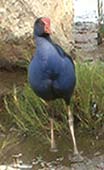
SWAMP HEN – kor rung un un
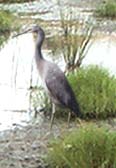
WHITE-FACED HERON
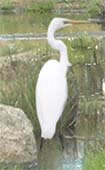
GREAT EGRET – karween
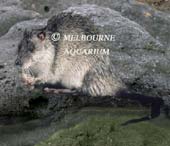
Photograph courtesy Melbourne Aquarium.
DAYANG (W) (Indigenous Water Rat)
Rakali hunts on the bank of the river in the early morning or evening and dives for a wide variety of prey including fish, crustaceans, shellfish, frogs, water birds, turtles, spiders, bats and aquatic insects.
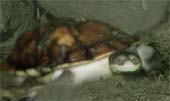
SNAKE-NECKED TURTLE
The Snake-necked Turtle has a long neck, which is usually about half the length of its shell. It is almost exclusively carnivorous and eats anything small enough to seize and swallow such as fish, tadpoles, crustaceans, insects and carrion. It is a long-lived creature with a life-span similar to that of humans.
(Turtle/tortoise) bundabun (W) barribin (B)

FISH – Dugat (W) tarlum (B)
The Maribyrnong estuary is home to a wide range of fish, some of which move through on their breeding and seasonal migrations, while others spend much of their lives there. The tiny, young fish larvae float around in the water together with the massive populations of other ‘plankton’, the small plants and creatures, such as algae, protozoa, and the larvae of other animals including worms, crabs and shellfish. Many of these form the staple diet of the young fish.
The following list of fish are those that have been seen in the Maribyrnong and surrounding wetlands by local observer and researcher, Michael Patti and his friends, over the last fifteen years.
Shortfinned Eel, Longfinned Eel, Common Jollytail, Eastern Little Galaxias, Spotted Galaxias, Grayling, Smallmouth Hardyhead, Southern Pygmy Perch, Yarra Pygmy Perch, River Blackfish, Sea Mullet Yelloweyed Mullet, Flat-tail Mullet, Congolli, Flathead Gidgeon, Dwarf Flathead Gidgeon, Blue Spot Goby, Largemouth Goby, Bridled Goby, Half- bridled Goby, Tamar River Goby, Trident Goby, Glass Goby, Oyster Blenny, Jewfish, Southern Black Bream, Eastern Yellowfin Bream, Snapper, Australian Salmon, White Trevally, Tailor, King George Whiting, Fortesque, Southern Garfish, Blue Sprat, Smooth Toadfish and Globe fish. Including introduced fish such as Carp, Oriental Weatherloach, Redfin Perch, Brown Trout, Yellow-finned (Japanese) Goby and the Western Mosquito Fish.
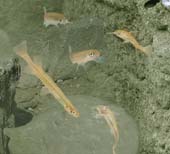
JOLLYTAIL GALAXIA
A small indigenous fish found in the Maribyrnong River.

BRIDAL GOBIE
A small indigenous fish found in the Maribyrnong River.
Images of each of the animals in this exhibition are available to purchase in a high resolution format. All enquiries should be directed to admin@livingmuseum.org.au or by telephone on +613 9318 3544.
